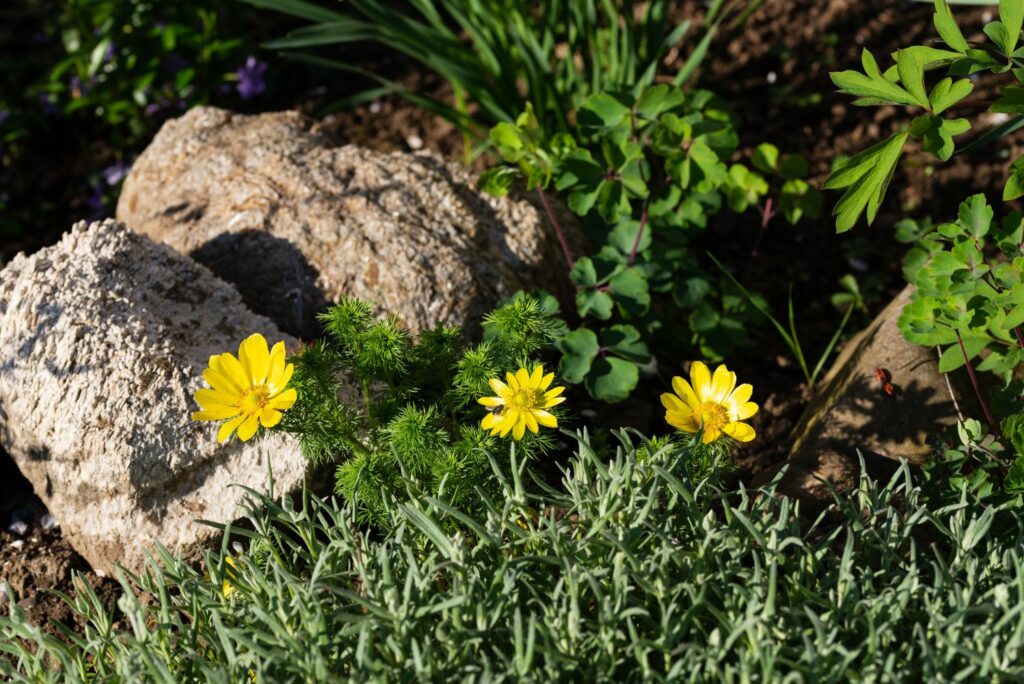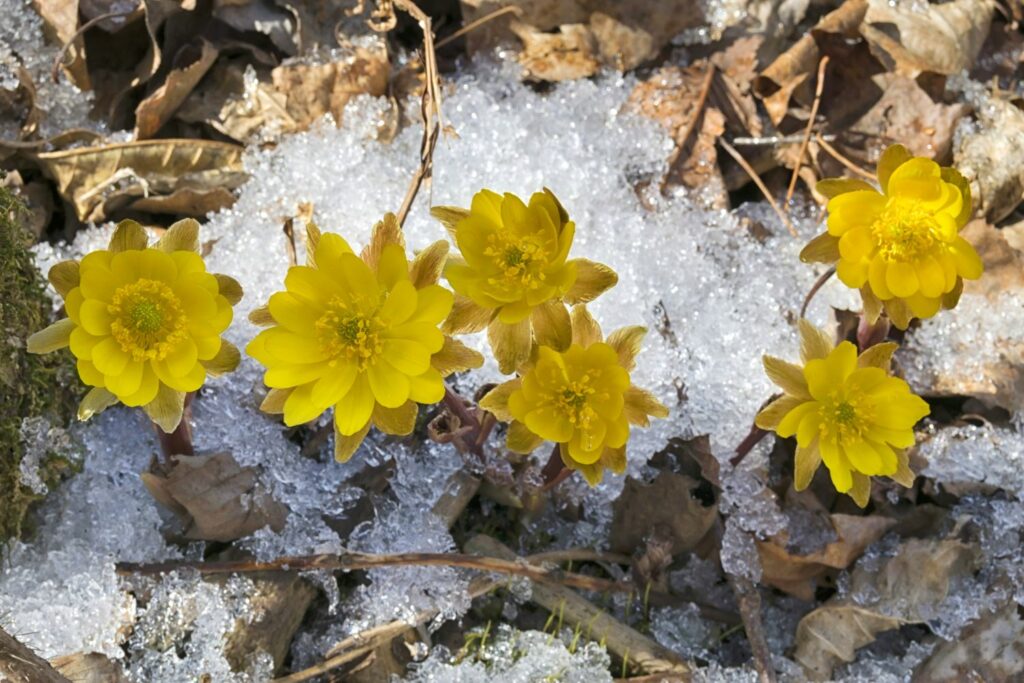Adonis flower: flowering time, location and toxicity
The Adonis plant is extremely rare in nature, but if you have a suitable location, you can grow this beautiful flower in your own garden.

The adonis flower (Adonis), also known as pheasant’s eye, has a different species for every season. The flowers of the spring pheasant’s eye appear early in the year. This is then followed by various species until the season ends with the blooming of the autumn pheasant’s eye. Read on to find out how to plant Adonis flowers, what the most important care measures are, and whether the Adonis plant is poisonous.
Contents
Adonis: flower, origin, and characteristics
According to legend, blood-red flowers grew from the drops of blood of the dying Adonis from Greek mythology. The name Adonis only refers to the red-flowering varieties of the approximately 30 to 35 species that belong to the genus Adonis. The flowers, which range in size from 2 to 7 cm, can also be yellow or even white. Adonis plants are primarily pollinated by insects. Despite the fact that they only produce pollen and no energy-rich nectar, wild bees as well as beetles enjoy visiting the flowers, ensuring the adonis flower’s reproduction.

Adonis’ flowering time varies by species and is frequently revealed in the name. The spring Adonis flower blooms from April to May, whereas the autumn Adonis flower blooms from late summer into September. The leaves of many species are finely pinnate and almost look like soft needles. The herbaceous plants are usually low-growing, with only the flowers reaching a height of up to 50 cm. The deep-rooted plant needs plenty of space in the ground. Adonis flowers can be annual or perennial, depending on the species. This means that some varieties die in autumn and only their seeds survive the winter, whereas others form a rhizome as a survival organ and sprout again in spring.

Tip: Despite the fact that adonis flowers are native to our country, they have become extremely rare, and their population is rapidly declining. As a result, Adonis plants are now protected in the UK and cannot be picked.
The most beautiful adonis flower species
There are around 30 to 35 different species of Adonis. They vary in many ways including flowers, flowering time, and location requirements.
Spring pheasant’s eye (Adonis vernalis)
Spring pheasant’s eye (Adonis vernalis), also known as spring adonis, delights from April onwards with its sunny yellow flowers up to 8 cm in size. This perennial dies back in summer and does not sprout again from its rhizome until the following spring. Spring Adonis prefer dry to fresh, well-draining, calcareous soil and thrive in rock gardens and wild open spaces.

Summer pheasant’s eye (Adonis aestivalis)
Summer pheasant’s eye flower (Adonis aestivalis), also known as aummer adonis, has blood-red flowers with dark centres and feathery green leaves. It flowers from May to June. The summer pheasant’s eye is an annual, so it must be resown every year. It prefers sunny locations with calcareous, well-draining and rather dry soils.

Autumn pheasant’s eye (Adonis annua)
Autumn pheasant’s eye (Adonis annua), also known as autumn adonis, is also an annual and reaches a maximum height of 40 cm. From August to September, it shows its small deep scarlet flowers, about 2.5 cm in size. Its location requirements are similar to those of the summer pheasant’s eye.

Amur adonis (Adonis amurensis)
Amur adonis flower (Adonis amurensis hort.) is a sterile hybrid of two Adonis species and therefore cannot spread by seed. In contrast with the other varieties, this hybrid grows in both sunny and semi-shady areas with fresh, neutral to acidic soils. The amur adonis is a perennial that flowers very early, sometimes as early as the end of January. It has yellow flowers.

Planting adonis plants: soil and location
The location requirements of the adonis flower differ slightly between species. For many, however, a sunny, chalky, summer-dry, and humus-rich location is ideal. If you have purchased an Adonis plant in a container or a pot, the best time to plant it is in spring:
- Loosen up the soil and remove any weeds to prepare the flowerbed. For clay soil, it is best to mix in some sand to make it more permeable. Aim for about 30% of the soil to consist of sand and small stones.
- Dig planting holes about 30 cm apart. The holes need to be slightly wider and deeper than the pot in which the Adonis flower was purchased.
- Place the adonis plant in the prepared hole and fill to ground level with substrate.
- Firmly press the soil around the plant and water thoroughly.
- Do not let the soil dry out in the first month after planting the adonis flower.
It is also possible to sow Adonis seeds. Although they do not germinate until spring, the best time to plant is in Autumn, from September to October. This is due to the fact that storing Adonis seeds greatly reduces their germination capacity, and they only germinate after being exposed to cold temperatures.
- Remove any weeds and loosen the soil with a garden fork to make a finely tilled seedbed. If the soil is too loamy, add enough sand to lighten the soil.
- Either scatter the seeds broadly over the bed or sow in rows 20 cm apart. It is better to sow a little too densely at a depth of about 1 cm.
- There will be no change in autumn and winter because the seeds will not germinate until spring. A snow-covered soil offers the best conditions for the Adonis flower. This keeps the temperature underneath in the optimal range between -4 °C and 0 °C while also preventing the soil from drying out. A similar result can be achieved by adding a mulch layer of brushwood.
- Make sure that the substrate does not dry out in spring before and after germination.
- Once the seedlings are a few centimetres tall, space them 25 – 30 cm apart.
Tip: Be patient. It can take two to three years for the first flowers to appear on the spring pheasant’s eye.

Adonis flower care: the most important measures
Even though adonis plants have high demands when it comes to location, once established, they require very little care.
During dry periods, water juvenile plants occasionally. Once the perennial species are established, they no longer need watering thanks to their deep, branched root system.
Pruning is not necessary. Adonis flowers do not like competition. Therefore, make sure that no competitive plants spread in the immediate vicinity that could shade the adonis plant.
Tip: Always wear gloves when handling adonis plants. Skin contact can cause rashes and similar skin irritations.

The beautiful flowering plants do not usually require fertilisation, but you can support their health and growth by doing so. The best time to fertilise depends on the species. For early-flowering Adonis plants, it must be done early in the year in February or March. For species that flower later in the year, it is sufficient to apply the fertiliser at the beginning of growth. Our Plantura Flower Food is ideal for Adonis plants. Thanks to its mainly organic composition, its nutrients are released slowly and over a longer period of time. It is also 100% animal-free and child and pet friendly. Alternatively, use a well-matured compost as a fertiliser.

- Perfect for flowering plants in the garden & on the balcony
- For healthier plants with beautiful & long-lasting blossoms
- Long-lasting fertiliser that is free from animal products - child & pet friendly
Pheasant’s eyes are not susceptible to most diseases and pests. Only slugs enjoy the plants, which are toxic to many other animals. As a result, exercise caution, especially during extended periods of wet weather. Read our other article to learn how to protect plants from slugs.
Overwintering adonis plants
The perennial Adonis flowers are very winter hardy, surviving temperatures as low as -40 °C. This means that you can leave the plants in the soil all year round without concern.
Propagating adonis plants
This flower is notoriously difficult to propagate. Because most species do not tolerate division well, it is best to propagate by seed. This can be difficult because Adonis seeds have a low germination rate and seedlings take time to establish themselves. You can still try sowing self-harvested Adonis seeds if you pay attention to a few details.
- Depending on the species, the nuts ripen at different times. Keep an eye on your plants and harvest its fruits when they are brown and dry. Wear gloves when doing this.
- Remove the seeds from the nutlets and store them in a cool, dark, and dry place until sowing.
- Sow either in autumn or spring.

Is the adonis flower poisonous?
Adonis flowers are very poisonous. Parts of the plant contain cardiac glycosides, which can cause poisoning symptoms like nausea, vomiting, cramps, and diarrhoea. Even eating small amounts can have serious consequences and mere skin contact often causes rashes. Adonis plants are also poisonous to many animals, including dogs, horses, and cats. When used correctly, however, certain ingredients of the Adonis have been used in medicine for a long time.



















